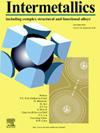The strengthening mechanism of Al-Mg-Si-Cu alloy laser-arc hybrid welds with Ni alloying
IF 4.3
2区 材料科学
Q2 CHEMISTRY, PHYSICAL
引用次数: 0
Abstract
The strategic incorporation of nickel alloying in weld seams was investigated as a means to improve both the static and dynamic mechanical properties of high-performance Al-Mg-Si-Cu alloys laser-arc welds. Microstructural characterization revealed that Ni addition induced dual strengthening mechanisms: precipitation of Al3Ni particles and solid solution strengthening through Ni dissolution, accompanied by significant grain refinement. However, microstructural analysis revelaed a critical threshold effect: at Ni concentrations exceeding 1.8 wt%, Al3Ni particles formed continuous networks that initiated microcrack propagation under stress, ultimately leading to macrocrack formation in weld seam containing 3.6 wt% and 6.0 wt% Ni. Optimal mechanical performance was achieved at a 1.8 wt% Ni addition, where the weld seam exhibited a 23 % increase in yield strength (239 ± 2 MPa) and an 11 % enhancement in tensile strength (281 ± 3 MPa) compared to non-alloyed counterparts. The high temperature baking process further improved joint efficiency through precipitation hardening, with nano-scale βʹ particles, increasing the welded joint coefficient to 0.78. The synergistic combination of grain boundary strengthening, precipitation hardening, and solid solution strengthening resulted in exceptional fatigue performance, demonstrating a fatigue limit of 147 MPa (R = 0.1, N = 107) and a fatigue ratio of 0.46 exceeding those reported in previous studies on similar alloy systems.
Al-Mg-Si-Cu合金激光电弧复合焊缝与Ni合金的强化机理
为了提高高性能Al-Mg-Si-Cu合金激光弧焊的静态和动态力学性能,研究了在焊缝中加入镍合金的策略。显微组织表征表明,Ni的加入诱导了双重强化机制:Al3Ni颗粒的析出和Ni溶解的固溶体强化,并伴有明显的晶粒细化。然而,显微组织分析揭示了一个临界阈值效应:当Ni浓度超过1.8 wt%时,Al3Ni颗粒形成连续网络,在应力作用下引发微裂纹扩展,最终导致含有3.6 wt%和6.0 wt% Ni的焊缝形成大裂纹。当Ni添加量为1.8 wt%时,与非合金相比,焊缝的屈服强度提高了23%(239±2 MPa),抗拉强度提高了11%(281±3 MPa)。高温焙烧工艺通过沉淀硬化进一步提高了接头效率,纳米级β′颗粒的加入使焊接接头系数提高到0.78。晶界强化、沉淀硬化和固溶强化的协同作用使合金具有优异的疲劳性能,其疲劳极限为147 MPa (R = 0.1, N = 107),疲劳比为0.46,超过了以往同类合金体系的研究结果。
本文章由计算机程序翻译,如有差异,请以英文原文为准。
求助全文
约1分钟内获得全文
求助全文
来源期刊

Intermetallics
工程技术-材料科学:综合
CiteScore
7.80
自引率
9.10%
发文量
291
审稿时长
37 days
期刊介绍:
This journal is a platform for publishing innovative research and overviews for advancing our understanding of the structure, property, and functionality of complex metallic alloys, including intermetallics, metallic glasses, and high entropy alloys.
The journal reports the science and engineering of metallic materials in the following aspects:
Theories and experiments which address the relationship between property and structure in all length scales.
Physical modeling and numerical simulations which provide a comprehensive understanding of experimental observations.
Stimulated methodologies to characterize the structure and chemistry of materials that correlate the properties.
Technological applications resulting from the understanding of property-structure relationship in materials.
Novel and cutting-edge results warranting rapid communication.
The journal also publishes special issues on selected topics and overviews by invitation only.
 求助内容:
求助内容: 应助结果提醒方式:
应助结果提醒方式:


